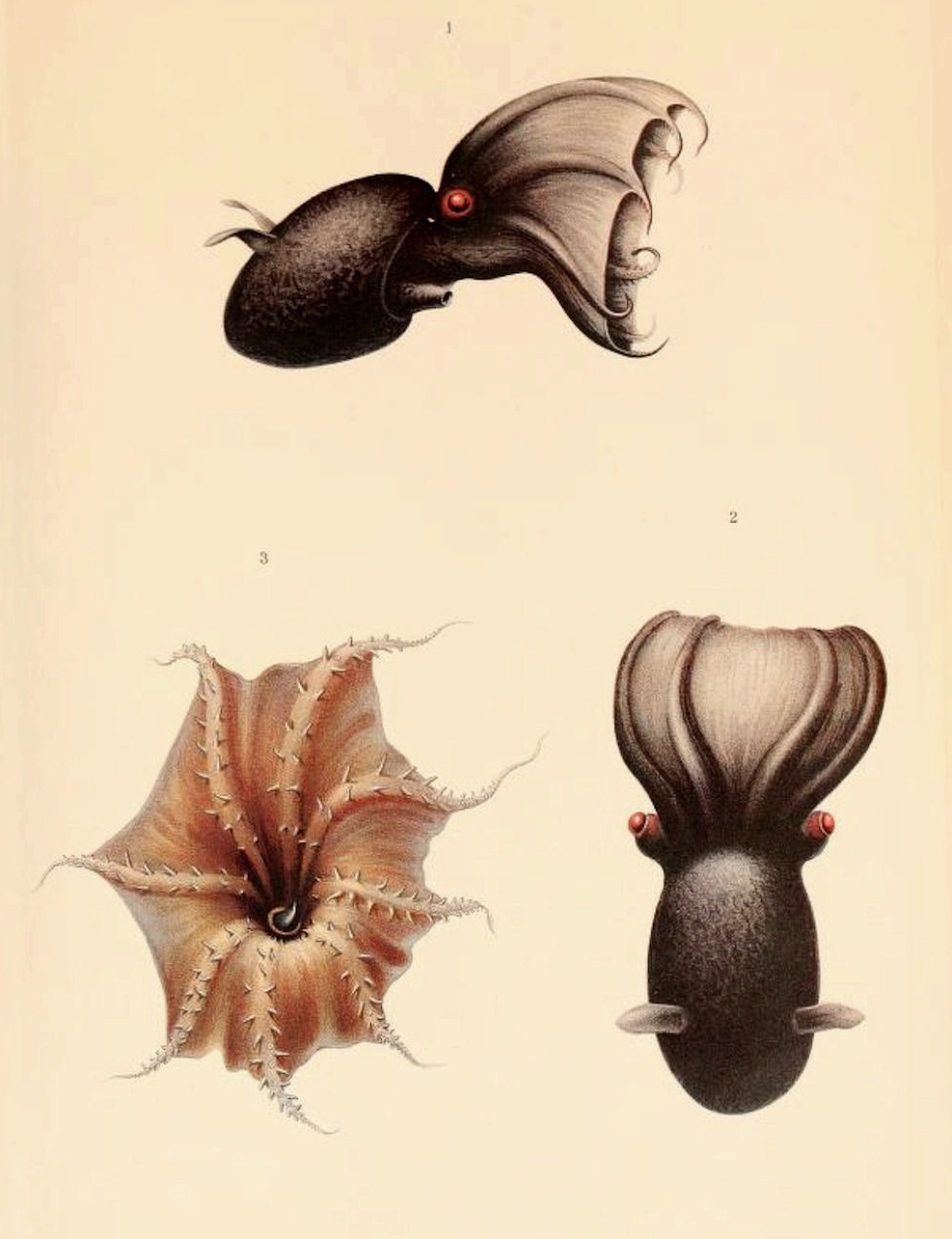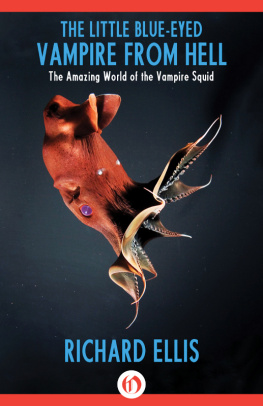
The Little Blue-Eyed Vampire From Hell
The Amazing World of the Vampire Squid
Richard Ellis

INTRODUCTION
THE GREAT FISH MOVED SILENTLY through the night water, propelled by short sweeps of its crescent tail. (I know, this is the opening sentence of Peter Benchleys novel Jaws, but bear with me, the rest is mine.) Its mouth hung open as it moved, so the water would pass over its gills and out through the five parallel openings on each side of its head. The pupils of its white-rimmed black eyes were dilated as much as possible; at this depth, little light penetrated. Only the tiny flashes of minute, bioluminescent creatures provided points of light in the absorbent blackness of the abyss. It was a great blue shark (a real animalits Prionace glauca, if you must know), ten feet long, and while all the dilation in the world wouldnt help you down here, if the scene were suddenly illuminated, you would see that this sleek beauty, often called the most graceful of all sharks, was brilliant ultramarine on its back, and gleaming white on its belly.
Sharks live for two things: eating and making more sharks. This one, alone in the darkness, was seeking the first option. It was 3,000 feet below the surface, in an environment inhabited by few shark species. There are, in fact, many deepwater sharks, but they are usually not more than a couple of feet long, and have never threatened anything larger than a herring. (Sorry. I forgot about the cookie-cutter shark, a foot-long species that scoops bite-sized chunks out of swordfish, marlins, tuna, and even whales. Doesnt kill them; just leaves a nasty scar.) The tremendous pressure of the depths does not affect the creatures that live down there. Most have no lungs, and therefore no air spaces to be compressed. Sharks have neither lungs nor swim-bladders, but they do have exquisitely tuned senses of hearing, smell, sight, movement, and a system of jelly-filled cells that can detect minute electrical charges in the waterthe kind given off by every living animal.
The blue shark was cruising in the dense, dark silence: looking for, listening for, hoping for food. No matter how good your eyes are, you cannot see very well in water. This is because water is not a particularly good conductor of light. (However, sound travels approximately seven times faster in water than it does in air.) In the gloom, the shark spotted two little blue lights, obviously part of the same animal, because they maintained the same distance from each other as they moved slowly through the water. As the sharks tail propelled it slowly forward through the water (sharks cannot swim backward), the blue lights seemed to be moving away or somehow getting smaller. As the shark sensed its immediate proximity to the lights owner, the lights blinked off, and a luminous cloud appeared before the sharks startled eyes. By the light of this cloud, the shark watched as the animal seemed to turn itself inside out: it wrapped itself in a black, spiky web and vanished into the surrounding blackness. The shark swam on.
1. The Vampire Appears
THERE ARE OCTOPUSES (thats the correct plural), and there are squid (thats the correct plural too), and then theres the vampire squid: Vampyroteuthis infernalis, whose name literally translates as vampire squid from hell. The name was bestowed upon this footlong, deepwater creature in 1909 by Carl Chun. Born in Germany in 1852, Chun was professor of biology at the University of Leipzig who organized a deep-sea expedition for zoological observation, on which he sailed aboard the steamship Valdivia from Hamburg on August 1, 1898.
The first specimen of Vampyroteuthis was trawled off the Guinea Basin in the Atlantic, at a depth of 1,400 meters (4,500 feet.) Chun, its discoverer, was a teuthologista specialist in that fascinating class of marine animal, the cephalopod (teuth is Greek for squid). He named the vampire squid for the surprising appearance of its dark red skin, purplish-black web, white beak, and deep-set red eyes, and this initiated the controversy about what sort of animal it actually was. Although Chun called it a squid, he described it as a somewhat gelatinous, small-finned octopus that he believed to be fairly inactive. Chun had the artist Ewald Rbsamen draw something that does not look very much like the Vampyroteuthis we know today, but Rbsamen can be excused because he never saw the animal alive; he saw only dead ones that had been hauled up in a net and preserved in jars.

Rbsamens original drawing of Vampyroteuthis doesnt
look very much like the animal we know today.
Aus den Tiefen des Weltmeeres (Chun, 1903)
If there was ever a nondescriptive common name, it would be the one commonly translated from Carl Chuns Vampyroteuthis infernalis. The chubby, blue-eyed little cephalopod does indeed live in the depthsbut its cold down there, not hotand it resembles a vampire (bloodsucking human or bat) about as much as it resembles a canary. The common names of some cephalopodsgiant squid, firefly squid, mimic octopus, flamboyant cuttlefish, flapjack devilfishare generally useful because they refer to a recognizable trait of the animal, but it is the scientific names that are supposed to eliminate linguistic confusion and enable anyone, in any language, to know which animal is being discussed. Whether you call it jumbo squid, Humboldt squid, or diablo roja, it is always Dosidicus gigas. Unfortunately, however, scientific names are not necessarily reliable guides to the kind of animal they are attached to. There is a large group of octopuses whose generic name is Octopus, such as Octopus vulgaris, (the common European octopus) and a group of squid whose generic name is Octopoteuthis, which has to be translated as octopus-squid. Adult Octopoteuthids have only eight arms, having lost the tentacles as paralarvae. The Caribbean reef squid, Sepioteuthis sepioidea, sort of resembles a cuttlefish, hence the double use of sepia (cuttlefish) in its scientific name.
During the years after Chuns discovery, Vampyroteuthis specimens were collected from the Atlantic, Pacific, and Indian Oceans, attributed to eleven species in eight genera. In 1929, Louis Joubin published the scientific report Notes prliminaires sur les cphalopodes des croisires du Dana, in which four specimens were described and illustrated. In Joubins report, there are two versions of the Rbsamen drawing that appeared in Chuns original paper, one with four fins and one with two. Then there are detailed descriptions of his four selected specimens (Melanoteuthis schmidti, Danateuthis schmidti, Retroteuthis [n. gen.], and Hansenoteuthis lucens). These are all illustrated, and with only minute variations, they closely resemble Vampyroteuthis.
After examining virtually every specimen that had ever been collected, Grace Pickford of the Bingham Oceanographic Laboratory at Yale University concluded that the two- and four-finned forms were likely growth stages of a single species, and that only one valid genus and species existed. She wrote:
The various genera and species of preceding authorscorrespond either to abnormalities resulting from the poor condition of the specimens, or to stages in the remarkable metamorphosis of the species. Furthermore, dissection of the specimens belonging to the Bingham Oceanographic Laboratory revealed that
Next page

















